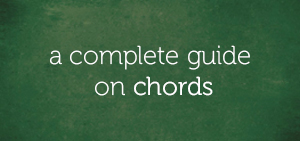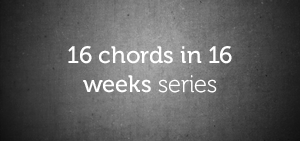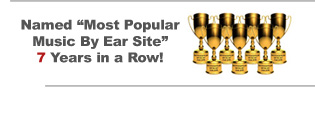In today’s lesson, we’ll be learning the essential chords used in the gospel music style.
But before we do so, let’s take a look at the basic concepts in the key of Eb major, where all our references will be drawn from.
Overview Of The Basic Concepts
The key of Eb major:
…has three flat notes in classical music theory – Bb:
…Eb:
…and Ab:
Therefore, if you apply that to all the white notes on the keyboard from E to E:
…you’ll lower B:
…to Bb:
…to form:
Next, you lower E-E:
…to Eb-Eb:
…to form:
“We’re Not Done Yet…”
There’s one more flat…and that’s Ab. So you lower A:
…to Ab:
…and you’ll have the Eb major scale:
…with three flats (Bb, Eb, and Ab).
Attention: The key of Eb major is so unique. All notes are white apart from do, fa, and sol notes, which are Eb, Ab, and Bb, respectively.
Basic Scales On Eb Major
There are vital scales you need to know in the key of Eb and here they are:
The Eb Natural Major Scale
The Eb Major Pentatonic Scale
The Eb Blues Scale
“Are You Ready?”
The Eb natural major scale:
…consists of all the notes in the key of Eb major.
The Eb major pentatonic scale:
…consists of all the notes in the Eb natural major scale:
…save the fourth and seventh tones (which are Ab and D respectively):
The Eb blues scale:
…is a minor pentatonic scale and is related to the key of Gb major:
That’s why 5 out of the 6 notes of the Eb blues scale:
…are in the Gb natural major scale:
Basic Chords
Get started with the most basic chords – they are called triads.
Here’s the numbers to use while forming triads in the key of Eb major:
There are seven tones in the any key, not eight. The eighth tone is usually a duplicate of the first tone. So the Eb major scale:
…has two Eb tones:
…the first:
…and the eighth (which is the duplicate):
“So, Here We Go…”
Eb = 1
F = 2
G = 3
Ab = 4
Bb = 5
C = 6
D = 7
Using the notes of the Eb major scale, you can form the following chords:
1 – 3 – 5 = Chord 1
2 – 4 – 6 = Chord 2
3 – 5 – 7 = Chord 3
4 – 6 – 1 = Chord 4
5 – 7 – 2 = Chord 5
6 – 1 – 3 = Chord 6
7 – 2 – 4 = Chord 7
“Let’s Add Notes To It…”
1 – 3 – 5 = Chord 1:
…the Eb major triad.
2 – 4 – 6 = Chord 2:
…the F minor triad.
3 – 5 – 7 = Chord 3:
…the G minor triad.
4 – 6 – 1 = Chord 4:
…the Ab major triad.
5 – 7 – 2 = Chord 5:
…the Bb major triad.
6 – 1 – 3 = Chord 6:
…the C minor triad.
7 – 2 – 4 = Chord 7:
…the D diminished triad.
Worship Chords In The Key Of Eb
Now that we’re done with the basics, let’s learn some chords and passing chords that we can play worship songs with.
Chords Starting On Eb (Chord 1)
The Eb major [add9] chord:
The Eb major ninth chord:
…which can also be played this way:
Chords Starting On F (Chord 2)
The F minor ninth chord:
…which can also be played this way:
You can turn heads with this one:
…the F minor eleventh chord.
Attention: First three notes of the F minor eleventh chord should be played on the left hand, while the last four notes should be played on the right hand.
Chords Starting On G (Chord 3)
The G minor seventh chord:
…which can also be played this way:
Here’s another one – the G minor eleventh chord:
Attention: The first three notes of the G minor eleventh chord should be played on the left hand, while the last four notes should be played on the right hand.
Chords Starting On Ab (Chord 4)
The Ab 6/9 chord:
The Ab major ninth chord:
…which can also be played this way:
Chords Starting On Bb (Chord 5)
The Bb sus4 chord:
The Bb dominant thirteenth [suspended fourth]:
…which can also be played this way:
Chords Starting On C (Chord 6)
The C minor ninth chord:
…which can also be played this way:
You can also check this one out:
It’s the C minor eleventh chord.
Passing Chords Starting On Eb (Resolving To Chord 4)
The Eb dominant seventh [flat ninth] chord:
The Eb dominant thirteenth [add9] chord:
…which can also be played this way:
Passing Chords Starting On F (Resolving To Chord 5)
The F dominant seventh [flat ninth] chord:
The F dominant thirteenth [add9] chord:
…which can also be played this way:
Passing Chords Starting On G (Resolving To Chord 6)
The G dominant seventh [flat ninth] chord:
The G altered chord:
…which can also be played this way:
Passing Chords Starting On Bb (Resolving To Chord 1)
The Bb dominant seventh [flat ninth] chord:
The Bb dominant thirteenth [add9] chord:
…which can also be played this way:
Passing Chords Starting On C (Resolving To Chord 2)
The C dominant seventh [flat ninth] chord:
The C altered chord:
…which can also be played this way:
Passing Chords Starting On D (Resolving To Chord 3)
The D dominant seventh [flat ninth] chord:
The D altered chord:
…which can also be played this way:
Application Of The Chords Learned
Let’s go ahead and apply the chords learned in a couple of worship songs.
Song Example #1 – El-shaddai, El-shaddai
El sha (passing chord 6):
…ddai, el sha (chord 2):
…dai, El-ly (chord 5):
…yon, and Ado (chord 1):
…nai, age to (chord 6):
…age you’re still the (chord 2):
…same, by the (chord 5):
…power of your (chord 1):
…name (chord 6):
El-sha (passing chord 6):
…ddai, el-sha (chord 2):
…dai, El-ly (chord 5):
…yon, and Ado (chord 1):
…nai, I will (chord 6):
…praise and lift you (chord 2):
…high, El-sha (chord 5):
…ddai (chord 1):
Song Example #2 – For You Are Glorious
For you are (passing chord 6):
…glori- (chord 2):
…ous and (chord 5):
…worthy to be (chord 1):
…praised, you’re the (chord 6):
…lamb u- (chord 2):
…pon the (chord 5):
…throne (chord 1):
Passing Chord (passing chord 6):
Unto (chord 2):
…You I (chord 5):
…lift my voice in (chord 1):
…praise, you’re the (chord 6):
…lamb u (chord 2):
…pon the (chord 5):
…throne (chord 1):
Final Words
There are are 24 chords and 36 chord voicings in this lesson and I can guarantee you that if you master these voicings, your chordal vocabulary will explode.
I recommend that you practice these chords in other keys as well.
See you in the next lesson!
Chuku Onyemachi
Latest posts by Chuku Onyemachi (see all)
- The Formation Of Diminished Seventh Chords Used To Be Challenging Until I Did This
- How To Form Seventh Chords In Two Shakes Of A Dog’s Tail Using Third Intervals And The Circle Of Fifths Chart
- I Played The 13sus4 Chord And This Happened…
- How To Build Seventh Chords Like An Architect Using “Foundation And Structure” Concept
- This 4-Week Plan Will Help You Master All The Major Scales







Comments on this entry are closed.